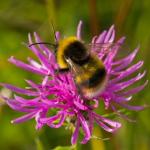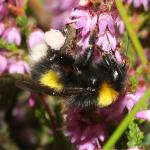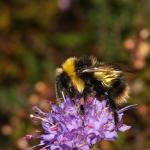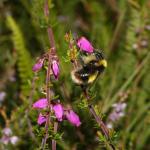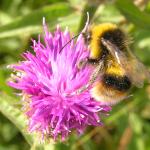Cardui (Müller, 1776); Proteus Gerstaecker, 1869; perplexus Radoszkowski, 1884, not of Cresson, 1863 (= B. perplexus Cresson) Radoszkowskyi Dalla Torre, 1890, replacement name for perplexus Radoszkowski, 1884:82; miniatocaudatus Vogt, 1909
For details see Williams Bumblebees of the world
Keys and general biology are found in Sladen (1912), Free & Butler (1959), Alford (1975) and Prŷs-Jones & Corbet (1991). A rather small yellow, black and white-banded bumblebee which can be rather difficult to distinguish from the very common Bombus lucorum. Although much is made in the literature of a centrally broken yellow band on the second segment of the abdomen, this is probably the worst field character to distinguish this species, being hard to discern with the naked eye. Even then one must be sure that the break is due to black hairs, not loss of yellow ones! Apart from its rather smaller size than B. lucorum, there are two characters which should alert one to the possibility of B. soroeensis. The yellow abdominal band on the second tergite often curves round onto the sides of the first and the tail is often suffused with a peachy colouring. However, neither of these characters is completely constant and then the only option is to look at the grooves on the mandible of females and the genitalia of males.
Much of England, Wales and Scotland. It is restricted to extensive areas of late-flowering grasslands and moorland. However, it appears to be absent from the dry heaths of south-eastern England and has disappeared from much of southern and eastern England. There are recent records from the Dungeness area, where it had been previously unrecorded. It is widespread in Europe, and in middle and northern latitudes of Asia, eastwards to northern Mongolia (Løken 1973).
This bee is not regarded as being scarce or threatened. However, modern research suggests that its status is in need of review.
Although it has always been considered strongly associated with extensive moorland in the north and west of the Atlas area, it does occur in a variety of other habitats, including the extensive calcareous grasslands of Salisbury Plain.
Univoltine. Nest searching queens are among the last species to emerge throughout its range, being present in June to August, according to latitude. The males, are similarly late to emerge, often not being seen until September and October.
This species nests underground in old mouse or vole nests. The nest is rather small, usually with fewer than 100 workers.
Visits are made to a variety of flowers, both for pollen and nectar.
No cuckoo-bee is known to attack this species in the Atlas area.
Profile written: 2006
Proofed: April 2012


